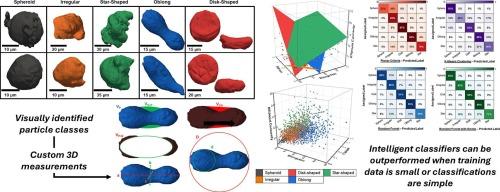通过三维 X 射线断层扫描数据和机器学习量化雾化原料粉末的通用分类方法
IF 4.5
2区 工程技术
Q2 ENGINEERING, CHEMICAL
引用次数: 0
摘要
激光粉末床熔融技术(LPBF)目前正被用于制造工程关键部件。为了保持稳定的零件质量,雾化金属原料粉末质量保证的准确性和速度至关重要。三维 X 射线层析成像 (XRT) 与机器学习算法相结合,为粉末表征和分类提供了一条变革之路。我们通过 XRT 对回收的 AA7050 原料粉末进行了研究,展示了一种对高度变形颗粒进行分类的方法,这些颗粒在几何形态和表面不规则程度上各不相同。对手动、无监督和有监督分类算法进行了优化,以再现视觉分类,展示了不同的算法训练方法如何在训练数据量和可接受的最终准确性之间取得平衡。所报告的方法提供了一种稳健的方法,将三维测量和粉末分类联系起来,作为控制粉末引起的缺陷和提高印刷部件机械性能的手段。本文章由计算机程序翻译,如有差异,请以英文原文为准。

Generalizable classification methodology for quantification of atomized feedstock powder by 3D X-ray tomography data and machine learning
Laser powder bed fusion (LPBF) is currently being applied to manufacture engineering-crucial components. To maintain consistent part quality, accuracy and speed in the quality assurance of atomized metal feedstock powder is critical. 3D x-ray tomography (XRT), coupled with machine learning algorithms, provides a transformative route to powder characterization and classification. A recycled AA7050 feedstock powder was studied through XRT to demonstrate a scheme for classification of highly deformed particles which vary both in geometric morphology and degree of surface irregularity. Manual, unsupervised, and supervised classification algorithms were optimized to reproduce visual classification, demonstrating how different approaches to algorithm training may provide a balance between the amount of training data and acceptable final accuracy. The reported approach provides a robust methodology that links 3D measurements and powder classification as means to control powder-induced defects and improve mechanical performance in printed parts.
求助全文
通过发布文献求助,成功后即可免费获取论文全文。
去求助
来源期刊

Powder Technology
工程技术-工程:化工
CiteScore
9.90
自引率
15.40%
发文量
1047
审稿时长
46 days
期刊介绍:
Powder Technology is an International Journal on the Science and Technology of Wet and Dry Particulate Systems. Powder Technology publishes papers on all aspects of the formation of particles and their characterisation and on the study of systems containing particulate solids. No limitation is imposed on the size of the particles, which may range from nanometre scale, as in pigments or aerosols, to that of mined or quarried materials. The following list of topics is not intended to be comprehensive, but rather to indicate typical subjects which fall within the scope of the journal's interests:
Formation and synthesis of particles by precipitation and other methods.
Modification of particles by agglomeration, coating, comminution and attrition.
Characterisation of the size, shape, surface area, pore structure and strength of particles and agglomerates (including the origins and effects of inter particle forces).
Packing, failure, flow and permeability of assemblies of particles.
Particle-particle interactions and suspension rheology.
Handling and processing operations such as slurry flow, fluidization, pneumatic conveying.
Interactions between particles and their environment, including delivery of particulate products to the body.
Applications of particle technology in production of pharmaceuticals, chemicals, foods, pigments, structural, and functional materials and in environmental and energy related matters.
For materials-oriented contributions we are looking for articles revealing the effect of particle/powder characteristics (size, morphology and composition, in that order) on material performance or functionality and, ideally, comparison to any industrial standard.
 求助内容:
求助内容: 应助结果提醒方式:
应助结果提醒方式:


